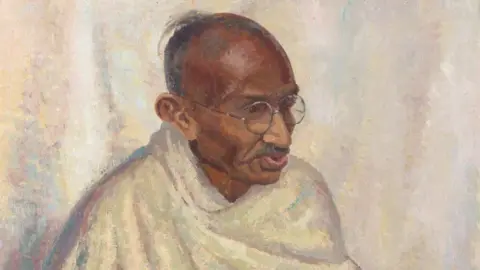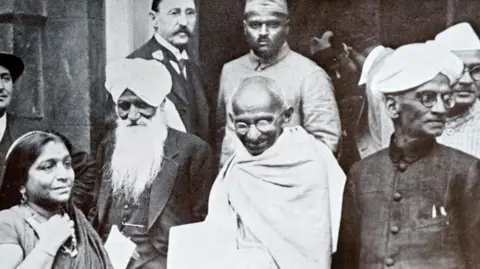Rare oil portrait of Mahatma Gandhi to be auctioned in London
 Bonhams
BonhamsA rare oil portrait of Indian independence leader Mahatma Gandhi - painted in 1931 in the UK - will be auctioned in London next month.
Gandhi led a non-violent resistance movement against British rule in India and his teachings have inspired millions. Most Indians revere him as the "father of the nation".
Over the years, several paintings, drawings and sketches of him have circulated around the world.
The auction house Bonhams says the painting, made by British artist Clare Leighton, is "thought to be the only oil portrait that Gandhi actually sat for".
The portrait was made when Gandhi went to London in 1931 for the second Round Table conference, held to discuss constitutional reforms for India and address its demands for self-governance.
It will be auctioned in the second week of July at Bonhams.
"This is a painting of unique historic and cultural significance. It would be great if it could be seen and appreciated more widely, whether in India or elsewhere," Caspar Leighton, a great nephew of the artist, told the BBC.
According to Bonhams, Clare Leighton "was one of the very few artists admitted to his office and was given the opportunity to sit with on multiple occasions to sketch and paint his likeness".
The works remained in the artist's collection until her death in 1989 in the US, after which it was passed down through her family.
She was introduced to Gandhi through her partner and British political journalist, Henry Noel Brailsford, who was a strong supporter of India's independence movement.
 Universal Images Group via Getty Images
Universal Images Group via Getty ImagesIn November 1931, Leighton showcased her portraits of Gandhi at an exhibition at the Albany Galleries in London.
Though Gandhi did not attend the opening event, several representatives from the Indian delegation of the second Round Table were present.
Among them was Sarojini Naidu, also an eminent Indian independence leader, who was one of the key advisors to Gandhi at the meeting.
The exhibition included a charcoal sketch of Gandhi, asleep in his office, along with the oil portrait that is now set to be auctioned.
About the painting of Gandhi, British Journalist Winifred Holtby wrote: "The little man squats bare-headed, in his blanket, one finger raised, as it often is to emphasise a point, his mouth parted for a word that is almost a smile".
The following month, Gandhi's personal secretary Mahadev Desai wrote to Leighton, saying, "many of my friends who saw it [the oil portrait] in the Albany Gallery said to me that it was a good likeness".
 Bonhams
BonhamsThere doesn't seem to be any public record of the oil portrait being displayed elsewhere until 1978, when the Boston Public Library organised an exhibition of Leighton's works.
However, according to the artist's family, the portrait was thought to have been on display in the 1970s in the US, where it was allegedly damaged in a knife attack.
A label attached to the backing board of the portrait says it was restored by the Lyman Allyn Museum Conservation Laboratory in Connecticut in 1974.
The details of the alleged attack are not clear - according to Bonhams, it was carried out by a right-wing Hindu activist.
Hindu hardliners in India accuse Gandhi of having betrayed Hindus by being too pro-Muslim, and blame him for the division of India and the bloodshed that marked Partition, which saw India and Pakistan created after independence in 1947.
He was shot dead on 30 January 1948 at a prayer meeting by Nathuram Godse, an activist with nationalist right-wing groups.
